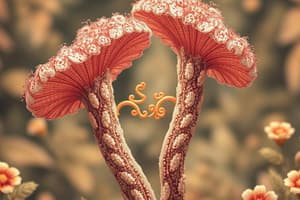Podcast
Questions and Answers
What is one main advantage of asexual reproduction?
What is one main advantage of asexual reproduction?
- It leads to greater variation in offspring.
- It allows for rapid reproduction without a mate. (correct)
- It occurs more slowly, preventing competition.
- It produces genetically diverse offspring.
Which of the following is a disadvantage of asexual reproduction?
Which of the following is a disadvantage of asexual reproduction?
- It results in rapid population growth.
- It produces a variety of offspring.
- It can lead to harmful genes being passed on. (correct)
- It increases genetic diversity.
What benefit does sexual reproduction offer over asexual reproduction?
What benefit does sexual reproduction offer over asexual reproduction?
- Prevents the transfer of harmful genes.
- Allows for quick population expansion.
- Creates genetically diverse offspring. (correct)
- Produces identical offspring.
Why might a plant that reproduces asexually be at risk in changing environments?
Why might a plant that reproduces asexually be at risk in changing environments?
Which of the following is NOT an advantage of sexual reproduction?
Which of the following is NOT an advantage of sexual reproduction?
What can result from rapid asexual reproduction in terms of population dynamics?
What can result from rapid asexual reproduction in terms of population dynamics?
Which feature of sexual reproduction contributes to genetic variation?
Which feature of sexual reproduction contributes to genetic variation?
What is a consequence of asexual reproduction that can make populations vulnerable?
What is a consequence of asexual reproduction that can make populations vulnerable?
Which of the following statements about asexual reproduction is false?
Which of the following statements about asexual reproduction is false?
What characterizes asexual reproduction?
What characterizes asexual reproduction?
Which type of asexual reproduction involves the division of a bacterial cell?
Which type of asexual reproduction involves the division of a bacterial cell?
How do fungi typically spread to new sources of food?
How do fungi typically spread to new sources of food?
What is a primary function of tubers in potatoes?
What is a primary function of tubers in potatoes?
What part of the fungus contains the spores?
What part of the fungus contains the spores?
Which process involves the growth of buds on a yeast cell?
Which process involves the growth of buds on a yeast cell?
What happens to potato tubers when conditions become favorable?
What happens to potato tubers when conditions become favorable?
During which stage do bacteria reproduce rapidly through cell division?
During which stage do bacteria reproduce rapidly through cell division?
Which component of a fungus is responsible for anchoring it to the substrate?
Which component of a fungus is responsible for anchoring it to the substrate?
What distinguishes sexual reproduction from asexual reproduction?
What distinguishes sexual reproduction from asexual reproduction?
Flashcards
Germinating Eye Bud
Germinating Eye Bud
A bud that develops into a new potato plant. It's located on the surface of a potato.
Scar of old stem
Scar of old stem
A depression on the surface of a potato where a stem or leaf was previously attached. These scars indicate the potato's age.
Scar of scale leaf
Scar of scale leaf
A depression on the surface of a potato where a scale leaf was previously attached. These are smaller scars compared to the 'scar of the old stem'.
Asexual Reproduction
Asexual Reproduction
Signup and view all the flashcards
Vegetative Propagation
Vegetative Propagation
Signup and view all the flashcards
Sexual Reproduction
Sexual Reproduction
Signup and view all the flashcards
Withstand Unfavorable Conditions
Withstand Unfavorable Conditions
Signup and view all the flashcards
Evolution
Evolution
Signup and view all the flashcards
Lack of Variation
Lack of Variation
Signup and view all the flashcards
Fusion of Haploid Nuclei
Fusion of Haploid Nuclei
Signup and view all the flashcards
Gametes
Gametes
Signup and view all the flashcards
Binary Fission
Binary Fission
Signup and view all the flashcards
Reproduction by Spores
Reproduction by Spores
Signup and view all the flashcards
Budding
Budding
Signup and view all the flashcards
Tubers
Tubers
Signup and view all the flashcards
Sporangium
Sporangium
Signup and view all the flashcards
Sporangiophore
Sporangiophore
Signup and view all the flashcards
Rhizoid
Rhizoid
Signup and view all the flashcards
Potato Tuber
Potato Tuber
Signup and view all the flashcards
Study Notes
Reproduction
- Reproduction is the process of creating more organisms of the same type.
- There are two main types: sexual and asexual.
Asexual Reproduction
- Definition: Asexual reproduction creates genetically identical offspring from a single parent, without gametes.
- Methods:
- Binary fission: Bacteria reproduce by dividing into two identical daughter cells. This can happen every 20 minutes.
- Spores: Fungi reproduce through spores that are spread by wind. When spores land in a suitable environment, they germinate and grow into new fungi.
- Budding: In yeast, a small bud grows from the parent cell, eventually separating to become an independent organism.
- Tubers: Certain plants like potatoes use tubers (short, enlarged stems) as a method of asexual reproduction. The eyes on the tuber contain buds that develop into new plants.
Advantages of Asexual Reproduction
- Speed: Often rapid, no need for a mate
- Identical offspring: Produces genetically identical offspring which may be advantageous if the parents have desirable traits
- Adaptability: Can easily adapt to good conditions using stored food
- Disease resistance: Maintains desirable traits from parent(s)
Disadvantages of Asexual Reproduction
- Less variation: Lack of variation/diversity can be harmful, making offspring vulnerable to environmental changes and diseases.
- Overcrowding: Rapid production can lead to overcrowding and competition.
- Harmful gene transfer: Harmful genes from parents are transferred to offspring.
Sexual Reproduction
- Definition: Sexual reproduction involves the fusion of haploid nuclei (from the male and female) to form a diploid zygote, producing genetically different offspring.
Studying That Suits You
Use AI to generate personalized quizzes and flashcards to suit your learning preferences.





